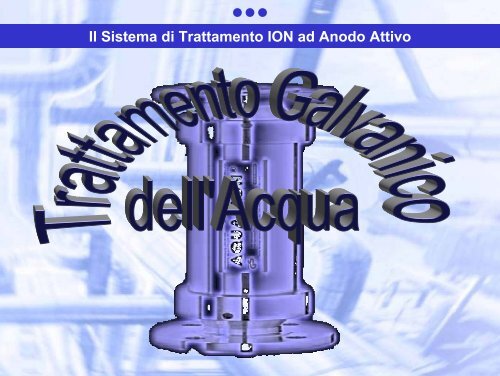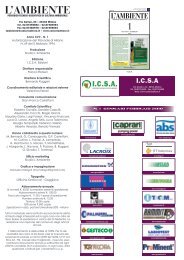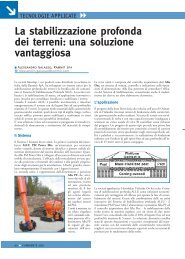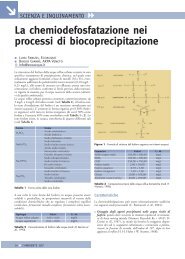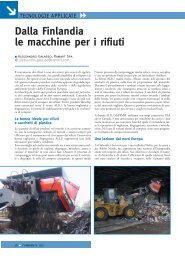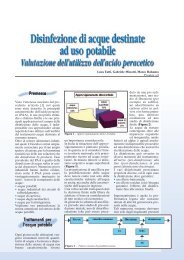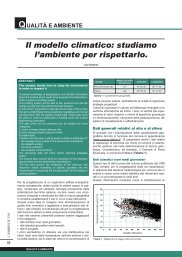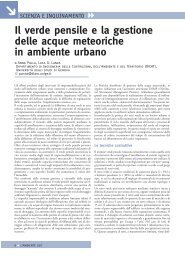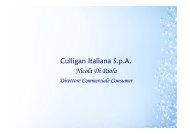Il Sistema di Trattamento ION ad Anodo Attivo - Ranieri Editore
Il Sistema di Trattamento ION ad Anodo Attivo - Ranieri Editore
Il Sistema di Trattamento ION ad Anodo Attivo - Ranieri Editore
Create successful ePaper yourself
Turn your PDF publications into a flip-book with our unique Google optimized e-Paper software.
Das I.O.N. ® <strong>Il</strong> <strong>Sistema</strong> <strong>di</strong> <strong>Trattamento</strong>Verfahren <strong>ION</strong> <strong>ad</strong> <strong>Anodo</strong> <strong>Attivo</strong>
<strong>Il</strong> <strong>Sistema</strong> <strong>di</strong> <strong>Trattamento</strong> <strong>ION</strong> <strong>ad</strong> <strong>Anodo</strong> <strong>Attivo</strong><br />
Tutti i tubi per acqua devono<br />
essere protetti contro:<br />
e
Das I.O.N. ® <strong>Il</strong> <strong>Sistema</strong> <strong>di</strong> <strong>Trattamento</strong>Verfahren <strong>ION</strong> <strong>ad</strong> <strong>Anodo</strong> <strong>Attivo</strong><br />
Corrosione ...<br />
... Dipende dalla composizione dell’acqua,<br />
in particolare dal suo gr<strong>ad</strong>o <strong>di</strong> durezza.<br />
Durezza...<br />
... è determinata dagli ioni <strong>di</strong> calcio e <strong>di</strong> magnesio presenti e dal<br />
valore del PH<br />
l’acqua dolce attacca tutti I tipi <strong>di</strong> metallo ,<br />
Tubi corrosi e bucati sono il risultato.
Das I.O.N. ® Verfahren<br />
<strong>Il</strong> <strong>Sistema</strong> <strong>di</strong> <strong>Trattamento</strong> <strong>ION</strong> <strong>ad</strong> <strong>Anodo</strong> <strong>Attivo</strong><br />
Corrosione superficiale:<br />
anche con asportazione <strong>di</strong><br />
materiale dalla parete del tubo.<br />
⇒ acqua”ferruginosa” e torbida.
<strong>Il</strong> <strong>Sistema</strong> <strong>di</strong> <strong>Trattamento</strong> <strong>ION</strong> <strong>ad</strong> <strong>Anodo</strong> <strong>Attivo</strong><br />
• Corrosione superficiale in tubi <strong>di</strong> rame:
Das I.O.N. ® The <strong>ION</strong> Active Anode Verfahren System<br />
”Ruggine” anche nei tubi <strong>di</strong> rame (pittatura)<br />
Distruzione
Dezincatura :<br />
<br />
Das I.O.N. ® The <strong>ION</strong> Active Anode Verfahren System<br />
<strong>Il</strong> <strong>Sistema</strong> <strong>di</strong> <strong>Trattamento</strong> <strong>ION</strong> <strong>ad</strong> <strong>Anodo</strong> <strong>Attivo</strong><br />
dell‘ottone e sue leghe.
Das I.O.N. ® The <strong>ION</strong> Active Anode Verfahren System<br />
<strong>Il</strong> <strong>Sistema</strong> <strong>di</strong> <strong>Trattamento</strong> <strong>ION</strong> <strong>ad</strong> <strong>Anodo</strong> <strong>Attivo</strong><br />
Calcificazione ...<br />
... <strong>di</strong>pende dalla composizione dell’acqua ,<br />
in particolare dalla sua durezza.<br />
Durezza...<br />
... è determinata dagli ioni <strong>di</strong> calcio e magnesio<br />
i depositi calcarei portano alla riduzione della sezione del tubo.<br />
la portata del tubo si riduce.
-<br />
<br />
Das I.O.N. ® The <strong>ION</strong> Active Anode Verfahren System<br />
<strong>Il</strong> <strong>Sistema</strong> <strong>di</strong> <strong>Trattamento</strong> <strong>ION</strong> <strong>ad</strong> <strong>Anodo</strong> <strong>Attivo</strong>
Das I.O.N. ® <strong>Il</strong> <strong>Sistema</strong> <strong>di</strong> <strong>Trattamento</strong>Verfahren <strong>ION</strong> <strong>ad</strong> <strong>Anodo</strong> <strong>Attivo</strong>
<strong>Il</strong> <strong>Sistema</strong> <strong>di</strong> <strong>Trattamento</strong> <strong>ION</strong> <strong>ad</strong> <strong>Anodo</strong> <strong>Attivo</strong>
Das I.O.N. ® <strong>Il</strong> <strong>Sistema</strong> <strong>di</strong> <strong>Trattamento</strong>Verfahren <strong>ION</strong> <strong>ad</strong> <strong>Anodo</strong> <strong>Attivo</strong>
-<br />
<br />
<strong>Il</strong> <strong>Sistema</strong> <strong>di</strong> <strong>Trattamento</strong> <strong>ION</strong> <strong>ad</strong> <strong>Anodo</strong> <strong>Attivo</strong>
Das I.O.N. ® <strong>Il</strong> <strong>Sistema</strong> <strong>di</strong> <strong>Trattamento</strong>Verfahren <strong>ION</strong> <strong>ad</strong> <strong>Anodo</strong> <strong>Attivo</strong>
<strong>Il</strong> <strong>Sistema</strong> <strong>di</strong> <strong>Trattamento</strong> <strong>ION</strong> <strong>ad</strong> <strong>Anodo</strong> <strong>Attivo</strong><br />
B<br />
M<strong>ad</strong>e in Germany<br />
®
Das I.O.N. ® <strong>Il</strong> <strong>Sistema</strong> <strong>di</strong> <strong>Trattamento</strong>Verfahren <strong>ION</strong> <strong>ad</strong> <strong>Anodo</strong> <strong>Attivo</strong><br />
La gamma degli apparecchi
Das I.O.N. ® <strong>Il</strong> <strong>Sistema</strong> <strong>di</strong> <strong>Trattamento</strong>Verfahren <strong>ION</strong> <strong>ad</strong> <strong>Anodo</strong> <strong>Attivo</strong><br />
AQUAB<strong>ION</strong> ®<br />
<strong>Il</strong> cuore dell’ AQUAB<strong>ION</strong> ® e un anodo<br />
attivo costituito da zinco <strong>ad</strong> altissimo<br />
gr<strong>ad</strong>o <strong>di</strong> purezza.<br />
Nelle due camere a monte ed a<br />
valle dell’anodo, si crea una elevata<br />
turbolenza nel flusso d’acqua al quale<br />
viene impresso un movimento zig-zag.<br />
Questa turbolenza concorre alla pulizia<br />
continua ed automatica dell’anodo,<br />
intensificando anche il processo<br />
galvanico in atto.
Das I.O.N. ® <strong>Il</strong> <strong>Sistema</strong> <strong>di</strong> <strong>Trattamento</strong>Verfahren <strong>ION</strong> <strong>ad</strong> <strong>Anodo</strong> <strong>Attivo</strong><br />
L’effetto <strong>di</strong> AQUAB<strong>ION</strong> ® è basato sul principio elettro-galvanico.<br />
<strong>Il</strong> cuore del sistema è l’anodo attivo <strong>di</strong> zinco purissimo.<br />
L’anodo è preceduto e seguito dalle due camere <strong>di</strong> turbolenza,<br />
dove si trovano elementi metallici in Nirosta (acciaio speciale) atti<br />
a realizzare un effetto ciclone. <strong>Il</strong> materiale sospeso nell’acqua e<br />
trascinato sul percorso, è spinto avanti dalla corrente, senza<br />
depositarsi sull’anodo, che si mantiene pulito mentre il trattamento<br />
si estende sull’intera superficie <strong>di</strong> contatto. <strong>Il</strong> collegamento<br />
conduttivo realizzato sul mantello dell’apparecchio, concorre nel<br />
processo <strong>di</strong> formazione <strong>di</strong> una cella elettrolitica, dove si instaura<br />
una <strong>di</strong>fferenza <strong>di</strong> potenziale tra 0,7 e 1V, che <strong>di</strong>pende anche dai<br />
valori caratteristici dell’acqua da trattare.
Das I.O.N. ® <strong>Il</strong> <strong>Sistema</strong> <strong>di</strong> <strong>Trattamento</strong>Verfahren <strong>ION</strong> <strong>ad</strong> <strong>Anodo</strong> <strong>Attivo</strong><br />
L’aggiunta all’acqua degli ioni <strong>di</strong> Zinco (ZN 2+ ) è più elevata della solubilità<br />
dello zinco nell’acqua. Si sviluppano i carbonati <strong>di</strong> zinco (ZnCO 3) che<br />
bombardano il calcare (CaCO 3) presente allo stato solubile. Quin<strong>di</strong> inizia<br />
un fenomeno <strong>di</strong> accrescimento delle particelle <strong>di</strong> carbonato <strong>di</strong> calcio<br />
me<strong>di</strong>ante agglomerazione fino a che esse non possano più precipitare in<br />
forma <strong>di</strong> cristalli sulla parete del tubo o sulle superfici degli scambiatori <strong>di</strong><br />
calore. Le reazioni chimiche in gioco sono le seguenti:<br />
CaCO 3 Ca 2+ + CO 3 2 - Zn 2+ + CO 3 2 - ZnCO 3
<strong>Il</strong> <strong>Sistema</strong> <strong>di</strong> <strong>Trattamento</strong> <strong>ION</strong> <strong>ad</strong> <strong>Anodo</strong> <strong>Attivo</strong>
Das I.O.N. ® <strong>Il</strong> <strong>Sistema</strong> <strong>di</strong> <strong>Trattamento</strong>Verfahren <strong>ION</strong> <strong>ad</strong> <strong>Anodo</strong> <strong>Attivo</strong><br />
L’elemento elemento galvanico: galvanico<br />
Si crea una <strong>di</strong>fferenza <strong>di</strong><br />
potenziale fino <strong>ad</strong> 1 V, in<br />
funzione delle caratteristiche<br />
dell’acqua dell acqua.
Das I.O.N. ® <strong>Il</strong> <strong>Sistema</strong> <strong>di</strong> <strong>Trattamento</strong>Verfahren <strong>ION</strong> <strong>ad</strong> <strong>Anodo</strong> <strong>Attivo</strong><br />
Protezione contro la corrosione<br />
L’effetto galvanico toglie ioni <strong>di</strong> zinco dall’anodo attivo<br />
dell’Aquabion, con il conseguente effetto <strong>di</strong> protezione<br />
cato<strong>di</strong>ca contro la corrosione per metalli come il ferro<br />
ed il rame. Lo zinco, in forma <strong>di</strong> carbonato, forma un<br />
sottilissimo strato protettivo sulla parete interna del<br />
tubo, che protegge oltrechè dalle incrostazioni, anche<br />
dalla corrosione.
Das I.O.N. ® <strong>Il</strong> <strong>Sistema</strong> <strong>di</strong> <strong>Trattamento</strong>Verfahren <strong>ION</strong> <strong>ad</strong> <strong>Anodo</strong> <strong>Attivo</strong><br />
Protezione contro le incrostazioni<br />
L’effetto galvanico toglie ioni <strong>di</strong> zinco<br />
dall’anodo attivo, si formano degli agglomerati<br />
cristallini con particelle finali <strong>di</strong> <strong>di</strong>mensioni<br />
cospicue.<br />
Queste particelle , così come come<br />
conformate, sono meno <strong>ad</strong>esive e vengono<br />
facilmente trascinate nel flusso d’acqua.
Das I.O.N. ® <strong>Il</strong> <strong>Sistema</strong> <strong>di</strong> <strong>Trattamento</strong>Verfahren <strong>ION</strong> <strong>ad</strong> <strong>Anodo</strong> <strong>Attivo</strong><br />
Rigenerazione dei sistemi <strong>di</strong> <strong>di</strong>stribuzione acqua<br />
corrosi ed incrostati.<br />
Due sono gli effetti ottenibili:<br />
1. Con l’impiego <strong>di</strong> AQUAB<strong>ION</strong> ® , non si formano nuovi depositi,<br />
in aggiunta a quelli già esistenti.<br />
2. I cristalli formatosi hanno una azione abrasiva sulle superfici<br />
incrostate. La rimozione delle incrostazioni avviene via via. Si<br />
forma lentamente uno strato protettivo anti-incrostazioni.<br />
Questo strato previene ulteriori fenomeni <strong>di</strong> corrosione ed<br />
incrostazioni.
Das I.O.N. ® <strong>Il</strong> <strong>Sistema</strong> <strong>di</strong> <strong>Trattamento</strong>Verfahren <strong>ION</strong> <strong>ad</strong> <strong>Anodo</strong> <strong>Attivo</strong><br />
<strong>Il</strong> trattamento<br />
galvanico<br />
Protezione<br />
contro<br />
corrosione<br />
AQUAB<strong>ION</strong><br />
AQUA <strong>ION</strong>®<br />
Protezione<br />
contro<br />
incrostazioni<br />
Azione preventiva e<br />
rigenerazione dei tubi<br />
Concorrenza<br />
<strong>Trattamento</strong> fisico<br />
dell‘acqua dell acqua<br />
(esempio esempio per via<br />
magnetica) magnetica<br />
Protezione<br />
contro<br />
incrostazioni<br />
(limitata)<br />
Nessuna<br />
Protezione<br />
contro<br />
corrosione
Protezione<br />
contro<br />
corrosione<br />
<strong>Il</strong> trattamento<br />
galvanico<br />
AQUAB<strong>ION</strong><br />
AQUA <strong>ION</strong>®<br />
<br />
Das I.O.N. ® Verfahren<br />
<strong>Il</strong> <strong>Sistema</strong> <strong>di</strong> <strong>Trattamento</strong> <strong>ION</strong> <strong>ad</strong> <strong>Anodo</strong> <strong>Attivo</strong><br />
Protezione<br />
contro<br />
incrostazioni<br />
Azione preventiva e<br />
rigenerazione dei tubi<br />
Concorrenza<br />
<strong>Trattamento</strong> chimico<br />
dell‘acqua dell acqua<br />
(con <strong>ad</strong>docitori)<br />
<strong>ad</strong>docitori<br />
Estrazione<br />
dall‘acqua<br />
del calcio<br />
Protezione contro<br />
corrosione con<br />
prodotti chimici
Das I.O.N. ® Verfahren<br />
<strong>Il</strong> <strong>Sistema</strong> <strong>di</strong> <strong>Trattamento</strong> <strong>ION</strong> <strong>ad</strong> <strong>Anodo</strong> <strong>Attivo</strong>
Das I.O.N. ® <strong>Il</strong> <strong>Sistema</strong> <strong>di</strong> <strong>Trattamento</strong>Verfahren <strong>ION</strong> <strong>ad</strong> <strong>Anodo</strong> <strong>Attivo</strong><br />
Prima Dopo
Das I.O.N. ® <strong>Il</strong> <strong>Sistema</strong> <strong>di</strong> <strong>Trattamento</strong>Verfahren <strong>ION</strong> <strong>ad</strong> <strong>Anodo</strong> <strong>Attivo</strong>
Das I.O.N. ® <strong>Il</strong> <strong>Sistema</strong> <strong>di</strong> <strong>Trattamento</strong>Verfahren <strong>ION</strong> <strong>ad</strong> <strong>Anodo</strong> <strong>Attivo</strong>
<strong>Il</strong> <strong>Sistema</strong> <strong>di</strong> <strong>Trattamento</strong> <strong>ION</strong> <strong>ad</strong> <strong>Anodo</strong> <strong>Attivo</strong>
Das I.O.N. ® <strong>Il</strong> <strong>Sistema</strong> <strong>di</strong> <strong>Trattamento</strong>Verfahren <strong>ION</strong> <strong>ad</strong> <strong>Anodo</strong> <strong>Attivo</strong>
<strong>Il</strong> <strong>Sistema</strong> <strong>di</strong> <strong>Trattamento</strong> <strong>ION</strong> <strong>ad</strong> <strong>Anodo</strong> <strong>Attivo</strong><br />
DN250 – <strong>ad</strong>atto per proteggere tubi <strong>di</strong><br />
raffreddamento, scambiatori <strong>di</strong> calore e<br />
per altre applicazioni industriali.
Das I.O.N. ® Verfahren<br />
<strong>Il</strong> <strong>Sistema</strong> <strong>di</strong> <strong>Trattamento</strong> <strong>ION</strong> <strong>ad</strong> <strong>Anodo</strong> <strong>Attivo</strong><br />
Assiemaggio finale AQUAB<strong>ION</strong> ®
Das I.O.N. ® <strong>Il</strong> <strong>Sistema</strong> <strong>di</strong> <strong>Trattamento</strong>Verfahren <strong>ION</strong> <strong>ad</strong> <strong>Anodo</strong> <strong>Attivo</strong>
Das I.O.N. ® <strong>Il</strong> <strong>Sistema</strong> <strong>di</strong> <strong>Trattamento</strong>Verfahren <strong>ION</strong> <strong>ad</strong> <strong>Anodo</strong> <strong>Attivo</strong>
Das I.O.N. ® <strong>Il</strong> <strong>Sistema</strong> <strong>di</strong> <strong>Trattamento</strong>Verfahren <strong>ION</strong> <strong>ad</strong> <strong>Anodo</strong> <strong>Attivo</strong>
Alcuni Clienti:<br />
<br />
<strong>Il</strong> <strong>Sistema</strong> <strong>di</strong> <strong>Trattamento</strong> <strong>ION</strong> <strong>ad</strong> <strong>Anodo</strong> <strong>Attivo</strong><br />
ABB, Alstom, Atmos, Bayer AG<br />
Bosch, Commerzbank, Danfoss<br />
Elkamet, Trevira, Linde Gas,<br />
Karst<strong>ad</strong>t AG, Rigips, RWE,<br />
St<strong>ad</strong>treinigung Hamburg,<br />
Vinnolit GmbH, Ter Hell Plastic<br />
Procter & Gamble.
Das I.O.N. ® <strong>Il</strong> <strong>Sistema</strong> <strong>di</strong> <strong>Trattamento</strong>Verfahren <strong>ION</strong> <strong>ad</strong> <strong>Anodo</strong> <strong>Attivo</strong><br />
Cosa è importante<br />
conoscere <strong>di</strong><br />
AQUAB<strong>ION</strong> ® ?
Das I.O.N. ® Verfahren<br />
<strong>Il</strong> <strong>Sistema</strong> <strong>di</strong> <strong>Trattamento</strong> <strong>ION</strong> <strong>ad</strong> <strong>Anodo</strong> <strong>Attivo</strong><br />
Dopo valutazione, senza impegno, della qualità dell’acqua a <strong>di</strong>sposizione è possibile<br />
stabilire se l’installazione <strong>di</strong> un Aquabion è giustificata. I parametri che influenzano<br />
l’eventuale decisione possono essere così elencati:<br />
- Conduttività: non deve essere inferiore a 150µ S/cm, poichè il numero <strong>di</strong> ioni che<br />
interverrebbero nel processo galvanico sarebbe insufficiente. In altre parole, non c’è<br />
ragione <strong>di</strong> utilizzare un processo galvanico, per esempio, con acqua <strong>di</strong>stillata, poichè<br />
l’effetto sarebbe nullo con conducibilità vicina allo 0.<br />
-PH: il limite più basso è pH = 5, poichè, con valori al <strong>di</strong> sotto, l’acqua è così corrosiva da<br />
ridurre sensibilmente la vita dell’anodo attivo.<br />
- Durezza: si può assumere il limite inferiore intorno a 4°dH per i carbonati: infatti solo con<br />
valori superiori a questo limite si può formare lo strato protettivo sulla parete interna dei<br />
tubi, che protegge sia dalle incrostazioni, sia dalla corrosione.
Das I.O.N. ® <strong>Il</strong> <strong>Sistema</strong> <strong>di</strong> <strong>Trattamento</strong>Verfahren <strong>ION</strong> <strong>ad</strong> <strong>Anodo</strong> <strong>Attivo</strong><br />
Quale durata ci si può aspettare<br />
dall’anodo sacrificale <strong>di</strong> zinco?<br />
Dipende dalle caratteristiche dell’acqua, se molto corrosiva<br />
o meno sulla base dei pH che si riscontrano nell’acqua<br />
potabile, la durata è superiore ai 5 anni, e si raccomanda la<br />
sostituzione dell’anodo al massimo dopo 7-8 anni.<br />
Per le applicazioni industriali si assume una durata max <strong>di</strong><br />
5 anni prima della sostituzione.
Das I.O.N. ® <strong>Il</strong> <strong>Sistema</strong> <strong>di</strong> <strong>Trattamento</strong>Verfahren <strong>ION</strong> <strong>ad</strong> <strong>Anodo</strong> <strong>Attivo</strong><br />
AQUAB<strong>ION</strong> riduce il contenuto <strong>di</strong> calcare?<br />
No, la concentrazione del calcare non viene ridotta. <strong>Il</strong> carbonato <strong>di</strong><br />
calcio è semplicemente mo<strong>di</strong>ficato nella sua struttura cristallina.<br />
Anzichè rimanere presente in forma solubile, il calcio<br />
rimane presente in forma cristallina. Non avviene quin<strong>di</strong> alcun<br />
processo <strong>di</strong> decalcificazione, che non è desiderabile, essendo i<br />
minerali elementi importanti nella <strong>di</strong>eta dell’uomo. Specialmente<br />
ciò è importante per i bambini, nel loro periodo <strong>di</strong> sviluppo.<br />
Infine i carbonati <strong>di</strong> calcio vengono <strong>di</strong>ssolti nello stomaco in<br />
presenza dei bassi livelli del pH.
Das I.O.N. ® <strong>Il</strong> <strong>Sistema</strong> <strong>di</strong> <strong>Trattamento</strong>Verfahren <strong>ION</strong> <strong>ad</strong> <strong>Anodo</strong> <strong>Attivo</strong><br />
QUALE L’EFFETTO DI AQUAB<strong>ION</strong>SULLE<br />
VARIE APPARECCHIATURE (BOLLITORI,<br />
LAVATRICI, CALDAIE)?<br />
Le particelle calcaree formate dopo il<br />
trattamento sono meno <strong>ad</strong>esive e possono<br />
facilmente essere rimosse dagli elementi e<br />
dalle superifici riscaldanti.
Das I.O.N. ® <strong>Il</strong> <strong>Sistema</strong> <strong>di</strong> <strong>Trattamento</strong>Verfahren <strong>ION</strong> <strong>ad</strong> <strong>Anodo</strong> <strong>Attivo</strong><br />
I servizi offerti:<br />
- Supervisione tecnica in sito<br />
- Analisi dell’acqua secondo normativa vigente<br />
- Installazione da parte <strong>di</strong> personale qualificato<br />
- Controllo dei risultati con ispezione della tubazione<br />
prima e dopo l’installazione <strong>di</strong> AQUAB<strong>ION</strong> ®<br />
- 5 anni <strong>di</strong> garanzia sul prodotto
Das I.O.N. ® <strong>Il</strong> <strong>Sistema</strong> <strong>di</strong> <strong>Trattamento</strong>Verfahren <strong>ION</strong> <strong>ad</strong> <strong>Anodo</strong> <strong>Attivo</strong><br />
I vantaggi in breve:<br />
Decomposizione lenta delle incrostazioni esistenti e<br />
dei depositi da corrosione.<br />
Prevenzione da formazione <strong>di</strong> nuove incrostazioni e<br />
riduzione dei rischi da corrosione.<br />
Risparmio notevole nei costi per l’estensione della durata dei tubi,<br />
bollitori, valvole e rubinetterie in genere, lavapiatti, lavatrici,<br />
scambiatori <strong>di</strong> calore ed anche torri <strong>di</strong> raffreddamento<br />
Non ci sono aggiunte <strong>di</strong> prodotti chimici nell’acqua.<br />
Non ci sono aumenti nei costi <strong>di</strong> esercizio.<br />
I costi per energia elettrica possono essere drasticamente ridotti.<br />
AQUAB<strong>ION</strong> ® non solo riduce I quantitativi <strong>di</strong> sapone, <strong>di</strong> detersivi<br />
e <strong>di</strong> sale da usare, ma anche anche I quantitativi <strong>di</strong> altri prodotti<br />
chimici impiegati e quin<strong>di</strong> un miglioramento dell’ambiente e<br />
risparmio notevole.
Das I.O.N. ® <strong>Il</strong> <strong>Sistema</strong> <strong>di</strong> <strong>Trattamento</strong>Verfahren <strong>ION</strong> <strong>ad</strong> <strong>Anodo</strong> <strong>Attivo</strong><br />
VI RINGRAZIAMO PER<br />
L’ATTENZ<strong>ION</strong>E<br />
CI AUGURIAMO QUANTO<br />
ESPOSTO ABBIA SUSCITATO<br />
IL VOSTRO INTERESSE .<br />
AQUAB<strong>ION</strong> ITALIA<br />
FLUIDEL SRL


